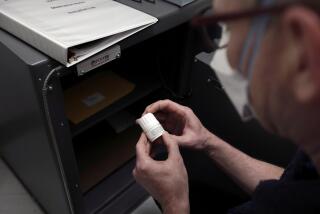4 1/2-Year Odyssey : Drugâs Long Road to FDA Approval
A small truck rumbled south from New Jersey in late 1983 with an unlikely one-ton load--an 851-volume application to the U.S. Food and Drug Administration for permission to sell a single drug for aching joints.
The drug, called Voltaren, was no major breakthrough. It represented little or no advance over what was already available, federal officials said. It was similar in many ways to a half-dozen other arthritis drugs the FDA had already approved.
But 4 1/2 years would slide by before the FDA approved Voltaren--more time than was taken to build Hoover Dam. Before Americans could use Voltaren, it would be available in 120 other countries and would become the top-selling arthritis drug in the world.
Time, Expense
Voltarenâs odyssey through the federal bureaucracy offers a graphic picture of the time and expense required to get a new drug on the market--conditions that lie at the heart of a bitter debate over Americansâ access, or lack of it, to innovative drugs.
It takes an average of 30 months to get a prescription drug through the FDA--on top of three to 10 years of development and testing. The cost of delays to firms, in added expenses and lost sales, has been estimated at $1 million a month--not to mention the price in public health.
Industry officials say the estimated $125-million cost of moving a drug from discovery to market has become a disincentive to pharmaceutical research. That research has helped spawn a $40-billion-a-year industry and extend the average Americanâs life span.
Meanwhile, public impatience for new treatments for diseases like AIDS and Alzheimerâs has inspired an outcry for an overhaul of the FDAâs review process. Some want the FDA to move more quickly; others want some approval requirements removed so new drugs will be available sooner.
That outcry has raised the question: Can the drug-approval system be made more efficient without risking disaster? Can it be accelerated without undermining the scientific scrutiny credited with keeping dangerous drugs like Thalidomide off the U.S. market?
âThe question is: What are the trade-offs?â Dr. Samuel O. Thier, president of the federal Institute of Medicine, said in a recent interview. âWhat are we gaining in terms of safety versus what are we giving up in not having drugs available for a year or two?â
Interviews with dozens of industry officials, regulators and others in recent months suggest that problems lie not in the design of the system itself, but in the conditions under which it has been forced to operate, perpetually hamstrung by shortages of funding and staff.
* Federal budget cutting in the last decade has left FDA staffing well below what it was just 10 years ago. For want of a typist, physician-reviewers often type lengthy drug reports themselves. Crucial FDA documents go untyped or unprinted for months.
Uncompetitive salaries make it difficult to hire qualified scientists for the FDA, and to keep them from defecting to private industry. Every year, the agency loses 10% of its drug reviewers, according to FDA Commissioner Frank Young.
* Working conditions at the FDA are notorious. Offices are overcrowded, equipment is outdated, desks are occasionally shared. Electronic equipment to speed the review process is donated or loaned by drug companies that the agency polices.
* The FDAâs workload has multiplied with the advent of AIDS, the rise of biotechnology and the development of new drugs for an aging population. Applications for permission to test AIDS products alone have multiplied--from five in 1982 to 275 in 1988.
Transfer of Staff
To handle the increase, FDA reviewers and other staff members have been reassigned to divisions handling AIDS drugs. Those transfers have left other offices and divisions riddled with vacancies, agency officials say.
The pharmaceutical industry often adds to the problem, studies by the FDA and industry researchers suggest. Firms impatient to get their products on the market sometimes take short cuts in designing their drug studies, then fail to meet FDA requirements.
As a result, time-consuming drug trials must be repeated and the review process is delayed while applications are ârecycledâ back and forth between the agency and companies.
âPeople seem to think itâs all the FDAâs fault,â said Thier, whose institute is part of the National Academy of Sciences. â(But) people are pressing for reducing the cost, increasing the safety, and getting drugs to market as fast as possible. You canât do all that simultaneously.â
âI donât think public policy has been terribly realistic,â added Dr. Theodore Cooper, chairman of the board and chief executive officer of the Upjohn Co. and a former U.S. deputy assistant secretary of health. âAs a company man right now, Iâd much rather see them have adequate resources and then I could feel better about bitching about their performance.â
Voltaren was far from an unknown quantity by the time the truck from the Ciba-Geigy Corp. backed up to the FDA loading dock on Dec. 20, 1983. It had been used widely by patients in Japan, Switzerland, France, Italy, Belgium and Germany since the mid-1970s.
For the previous three years, Ciba-Geigy had put it through the dozens of tests required by the FDA for approval. Scientists had tested the drug in animals, then in humans, on arthritic hips and arthritic knees, in studies lasting from six weeks to a year.
The data filled hundreds of colored binders. There were laboratory reports, analyses, medical records of thousands of patients. Binders were copied in triplicate for the FDAâs physicians, pharmacists, chemists, statisticians and specialists in pharmacokinetics.
Part of a Long Trip
Ingrid Fengler, a young Ciba-Geigy regulatory affairs specialist who had accompanied the application down from headquarters in Summit, N.J., watched as five yearsâ work disappeared into the massive belly of the FDA building in Rockville, Md., a suburb of Washington.
Did she ever imagine that another 4 1/2 years would elapse before approval?
âYou always assume itâs not going to go âone, two, three,â â Fengler answered, diplomatically.
The FDA, after all, is a gargantuan bureaucracy. It has more than 7,000 employees and a half-billion-dollar budget. It is the largest consumer-protection agency in the federal government, overseeing an estimated 25% of all consumer spending.
The time swallowed up in drug review has been a sore point since the 1970s, when it became apparent that it was taking close to a decade to get a drug to market. The FDA has tried repeatedly--and failed--to cut the average time required for approval.
âWeâve in one way or another been trying to âspeed things upâ for at least 15 years,â said Dr. Robert Temple, director of one of the FDAâs offices of drug evaluation. âBut the average approval time hasnât changed in a long time. Thereâs no question about it.â
Asked why, Temple said: âThatâs not easy to answer. One possibility is that weâre holding our own even though the (applications) are getting larger, and that what weâve been able to do is not so bad considering how much more there is.â
Reasons for Delay
But Fengler had other reasons to expect that approval would not come quickly: Arthritis drugs are toxic and can damage the digestive tract and liver. One year before, Eli Lilly & Co. had pulled one from the market amid reports of dozens of drug-induced deaths.
The drug, called Oraflex, had been approved just months earlier by the same FDA division that would later review Voltaren. Lilly was eventually prosecuted and fined $25,000 by the Justice Department for having withheld information about the drug from the FDA.
âWe look at each drug with the experience of the ones we have behind us,â said Dotti Pease, an FDA project manager on the Voltaren application. âIf (Lilly) had told us about the liver problems . . . we might have done something different.â
The Voltaren application reached Peaseâs division in early 1984. It went immediately to an in-house chemist for review. A second copy went to an FDA pharmacologist to review such things as the animal studies to determine how they might apply to humans.
According to Pease, the chemist completed his review early. The pharmacologist completed his in January, 1985--but then it took the pharmacologist six months to have the review typed, circulated and approved.
âThatâs not unusual,â Pease said, ensconced in a tiny office piled high with documents. âWe sometimes get to the point where if we just canât get enough typists to type things, we just put things in our files in handwriting--if you can read the reviewerâs writing.
âYou might have a hundred-page handwritten review in the file,â said Pease, adding later that the situation has begun to improve. âIf we just didnât see any hope of ever getting it typed, we would just put it in the file that way, hoping that people could read it.â
Centerpiece of Process
A third copy of the application went to an FDA physician for a so-called medical review, the centerpiece of the FDA process. That review entails weighing a drugâs benefits and risks, in addition to analyzing its side-effects, proper dosages and labeling.
The medical reviewer took about a year to complete his examination. It came in unusually long, at about 600 pages. Then, according to Pease, âThe reviewer got tired of waiting for a typist to type it. So he asked the company to type it.â
The company obliged--a step Pease acknowledged was highly irregular. But any question of appropriateness shortly became moot: The FDA reviewerâs supervisor felt the review was insufficiently rigorous and declined to sign off on it.
The reviewer eventually left the agency. His review languished on an office shelf.
âIâve never looked through it,â said Dr. Rudolph Widmark, the next reviewing medical officer to be assigned the case. âIt was a 600-page review, which I thought was a waste of time. You know, I have to construct my own way of looking at the data.â
The 1980s have not been happy times at the FDA.
Federal budget-cutting reduced full-time staff from about 8,000 in 1979 to less than 7,000 in 1986, according to congressional and FDA figures. Meanwhile, the number of applications to market new drugs rose from 182 in 1979 to 269 in 1983, one internal study shows.
The number of applications to begin testing new products skyrocketed--from 940 in 1979 to 1,904 in 1985. Applications to test AIDS products rose from five in 1982 to 60 in 1985 to 275 in 1988.
âThe FDA was and continues to be a lean organization,â said John Norris, an executive vice president of Hill & Knowlton, who served as FDA deputy commissioner between 1984 and 1988. âSo right away, the cuts went into meat and bone, and not into fat.â
Morale suffered too.
Political Dangers
Until the arrival of FDA Commissioner Frank Young in 1984, tenure in the top job averaged just over one year. The post had become âunrewarding . . . politically dangerous . . . (and) a public target for ridicule,â as Norris put it.
Travel budgets were so tight that, Norris said, âI often had to pay from my own pocket to cover government travel because meetings were held in expensive hotels and the government per diem doesnât cover a third of that.â
Pay for skilled professionals stands 30% to 500% below what the same people could earn in the private sector, Norris says. He recalls taking âa sixfold cut in payâ to come to the FDA from his job as chief executive officer of a management-consulting firm.
âHow do you hire an ophthalmologist for $65,000 a year?â asked Jere Goyan, a former FDA commissioner who is now dean of the UC San Francisco School of Pharmacy. âThatâs petty cash for an ophthalmologist.â
In late 1985, the Voltaren application encountered yet another delay: The FDA and Ciba-Geigy decided to computerize the medical review. In the long run, the FDA hopes computerization will speed up the process; but in the Voltaren approval process, it devoured another year.
It took the two sides four months to agree on terms for the new system. Then a consultant spent five months developing programs. By July, 1986, Ciba-Geigy had installed a terminal at FDA headquarters, giving the agency computer access to the companyâs data.
Later, the company installed a fax machine in the FDA reviewersâ office to speed up the review--an arrangement FDA officials said may raise questions about propriety but proved expedient.
Review in Earnest
Finally, in late 1986, the medical review began in earnest.
All through the following year, Widmark and his supervisor, Dr. John Harter, sorted through the Voltaren application. They re-examined data, scrutinized patient records, hunted out subtle side-effects.
Gradually, as Widmark worked with the data, he noticed an unexpected pattern in the way the drug affected patientsâ livers: The side-effects were worse in patients with osteoarthritis than in patients with rheumatoid arthritis.
That finding prompted the agency to require an addition to the drugâs labeling--the elaborate description of a drugâs chemistry, pharmacology, risks and proper use that goes to all prescribing physicians.
Because such labeling also dictates how the drug may be advertised, companies take labeling issues seriously. They know that physicians, or a competing drug firm, might take an unusual warning as grounds for not prescribing the drug.
After months of negotiation, the FDA and Ciba-Geigy agreed that the label would advise physicians to monitor the blood of patients on long-term Voltaren therapy. They were to test for certain enzymes whose presence can be a sign of liver injury.
But the advice was undercut by the FDAâs inability to specify when monitoring should be done. While the data from the drugâs trials suggested that monitoring might help avert more serious liver problems, it was unclear how often patients needed to be tested.
âWe hated at this end to recommend monitoring too specifically when the data didnât really show how often we should tell them to monitor,â Pease said.
There is little agreement on precisely how the drug-approval process might be changed.
Some industry officials would like to see the FDA less involved--for example, in determining when it is appropriate to advance from animal to human testing. Cooper of Upjohn suggests local hospital review boards could ensure that human tests are ethical and safe.
Others, including former FDA commissioner Goyan, want the agency to consider new statistical methods for extrapolating research findings to the general population. They wonder if it might be possible to test some drugs on fewer patients, saving time to approval.
Some top cancer researchers say the FDA should use more liberal standards in judging whether drugs work. For example, must sponsors prove that a cancer drug prolongs survival, or simply that patients responded and some biological function was restored?
The FDA, on the other hand, would like companies to turn in better applications. Commissioner Young likes to cite one that he calls âthe epic applicationâ: Seven of nine studies supporting the drug in question were âof no valueâ in the review, Young said.
But the agency has also made its own adjustments in recent months, under pressure in part from AIDS activists. The changes have included a commitment to allow drug testing to be shortened in the case of drugs for life-threatening diseases.
Some experts warn that there may be dangers in speeding up the process.
âThereâs always a risk in putting any drug on the market,â said Dr. F. Gilbert McMahon, who headed a commission on the FDA in the early 1980s. âNo drug is free of side-effects. Drugs are put on the market because their benefits seem to outweigh their risk.
âSo if you shorten the (trials) to 200 to 500 people before market, the public and the Congress have to know . . . that there are going to be some terrible mistakes,â said McMahon. âTheyâve got to be willing to accept that risk.â
By mid-April, 1988, all the FDA reviewers had largely completed their work on Voltaren. The next step was to present their written reports to Dr. Temple, the drug-evaluation office director with final say over when, and with what conditions, the drug would be approved.
Harter proposed that the reviews be presented to Temple orally in a marathon one-day workshop. The plan was to avoid the perpetual pileup of so-called approval packages awaiting Templeâs attention like aircraft waiting for permission to land.
âPackages historically have idled for quite a while. Itâs fair to say, certainly, for months,â said Pease. âWhat we tried to do was bring everybody into a room all at once and say, âSpeak now or forever hold your peace.â â
Twenty-five FDA officials convened at 9 a.m. on April 25 in a conference room on the 13th floor of the FDA building. Four floors below, in another conference room, a dozen Ciba-Geigy officials stood by to answer questions carried downstairs by runners.
The meeting lasted 11 hours. The Ciba-Geigy contingent missed the last plane back to New Jersey. But the session was pronounced a success: After three more months of discussions, Voltaren was approved.
On July 28, 1988, Voltarenâs 55-month odyssey ended. The FDA formally approved the drug. Fengler and Ron Califre of Ciba-Geigy took the first flight from New Jersey to Washington to pick up a copy of the approval.
âItâs traditional,â Califre explained of the final voyage. âItâs like delivering a baby.â
Applications Up, Manpower Down While the number of applications to begin testing of new AIDS drugs has been rising in recent years , FDA manpower has been declining. Number of applications per year: 1982: 5 1983: 8 1984: 29 1985: 60 1986: 104 1987: 164 1988: 275 (projected) FDA manpower (Full-time equivalents) 1979: 8,179 1980: 8, 089 1981: 7,799 1982: 7, 316 1983: (missing) 1984: 7,279 1985: 7,186 1986: 7,000 1987: 6,960 1988: 7,207 1989: 7,350 Source: FDA, congressional reports






